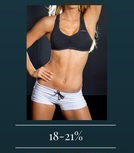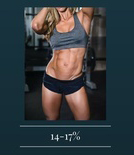Here in the land of tiny changes, we don’t often talk about the big picture. I can’t give you the one golden meal plan or the world’s best workout because they don’t exist – everyone is unique, starting from their own beginning and bringing their own baggage, and living within their own constraints of time, money, energy, and vision.
We are also up against the illusion that, with the right workouts in place, one can eat whatever they want and still have a lean, toned physique…despite the fact that, for most women, there’s a noticeable change between 23 and 35, when the combination of a sedentary desk job, easy access to takeout, adulting stress, and a little emotional eating suddenly add up to an increased pant size or two. You will never out-exercise a bad diet in terms of bodyfat percentage. You can eat whatever you want and get stronger, faster, and fitter, but you might not see the changes you’re seeking in the mirror.
Ignorance might be bliss, though, so if you love your pizza Fridays, your wine-not?! Wednesdays, and happy hour on Monday, Tuesday, and Thursday, close this post now.
This is all general information.
It might not apply to your specific circumstances, which is why it’s always best to get personalized advice from a qualified health and/or fitness professional that will help you get to your specific goals in a healthy way.
The lowest bodyfat percentage is not necessarily the best bodyfat percentage.
In the United States, the standard for a healthy female bodyfat percentage is roughly 21-33% – in this case, healthy means that your risk of disease isn’t likely being impacted by your bodyfat percentage, but your bodyfat percentage is also not so low that it is impacting your fertility, sleep, mood, or other key aspects of health, and it’s also not your constant concern and fixation.
People who attain low bodyfat percentages do not keep them at their lowest point all year long.
Qualified fitness competitors (those oiled-up folks in custom swimsuits who are up on stage sometimes) have “bulking”, or gaining, and “cutting”, or losing phases throughout a competition season. These phases are necessary in order to keep their bodies healthy. They do not look like their competition selves or magazine cover photos all year long.
In case you missed that line: they do not look like their competition photos all year long. They look like that for a week or two at a time, under very controlled circumstances, for a specific purpose.
As a trainer, I am primarily interested in your health, and in whatever goals you set for yourself.
I’m not suggesting that any of these bodyfat percentages are better, prettier, fitter, or secretly happier than any of the others. DO YOU. I field a LOT of questions about how to get rid of this/see that/why do I need to eat more/stop drinking so much, so I wanted a healthy, realistic reference about what it takes to, in general, reach these different physical states.
The photos in this post aren’t perfect. The women in the photos have different inherited body shapes/bone structures; these images are meant as an at-a-glance reference to start a conversation, not the defining standard. I am still on the lookout for better photos or illustrations!
Consistency is key in reaching any of these goals. I didn’t include any timeframes in this post because the time it will take you to drop fat will depend on how well you adhere to an effective program, how you’re sleeping, how quickly your trainer adapts your program to what is and isn’t working for your body, an other individual factors that are impossible to predict from behind a blog article.
 30-33% Bodyfat: Physically Healthy, Slight Muscle Definition
30-33% Bodyfat: Physically Healthy, Slight Muscle Definition
No matter what your starting point, 30% bodyfat is a great goal to reach for (for your health’s sake). For most women, it is relatively easy to reach this mark by:
- staying active during the day at least 4 days a week (if you have been significantly above 30% bodyfat for more than a year, this is extra-important for you)
- eating a reasonable but far from perfect diet that may include frequent-to-daily restaurant meals, occasional fast food, periods of undereating, periods of moderate overeating, and a fairly high alcohol intake
- strength training 1-2 times most weeks
- light to moderate cardio 1.5-3 hours most weeks

26-29% Bodyfat: Physically Healthy, Some Muscle Definition
Once you reach this range, it’s fairly easy to sustain. How to do it? For most women, it’s a matter of:
- eating a reasonable diet that generally provides sufficient nutrition (caloric intake generally within 10% of average daily output) that may include frequent restaurant meals and moderate alcohol intake
- total body strength training 1-2 times each week
- moderate cardio 2-3 hours most weeks
 22-25% Bodyfat: Physically Healthy, Increased Muscle Definition
22-25% Bodyfat: Physically Healthy, Increased Muscle Definition
For most women, this bodyfat percentage takes a bit more work and attention but can still be maintained throughout the year without dominating all of your waking attention, typically by:
- eating a diet of primarily whole foods that provides sufficient nutrition (caloric intake within 5% of average daily output, properly balanced macronutrients) and includes occasional restaurant meals, limited alcohol intake, and appropriate hydration
- total body strength training 1-2 times each week at full effort
- strategic, moderate cardio 2-3 hours most weeks and/or 1-2 hours vigorous cardio (or equivalent) on occasion
- sufficient rest

18-21% Bodyfat: Borderline Underfat, Increased Muscle Definition
For most women, this bodyfat percentage takes a lot of focus to maintain, and sleep and menstrual cycle issues may begin to crop up for some. This ongoing level of discipline is rarely sustainable for most women who have jobs, families, and other obligations outside of the gym (though this is the most common bodyfat range for elite female athletes), so it may be easier to consider this a “reach” goal for a vacation, photoshoot, or special occasion, followed by a return to 22-25% bodyfat. To reduce bodyfat this low typically takes:
- eating a whole food diet with sufficient caloric intake (approximately at average daily output or 5% over), appropriately balanced macros that include carbohydrates from primarily plant-based sources, ample hydration, and limited restaurant meals and/or alcoholic beverages on special occasions
- total body strength training 2-3 times each week at full effort, with an extra session on less-responsive areas
- strategic cardio – often a program that includes fasted morning cardio 3-5 times per week, along with interval training, and/or LISS
- sufficient rest
 14-17% Bodyfat: Likely Underfat, Significant Muscle Definition
14-17% Bodyfat: Likely Underfat, Significant Muscle Definition
For most women, this is a temporary level of bodyfat. At nearly competition-level lows, this level of bodyfat often requires near constant dedication to nutrition, training, and rest, and may interfere with sleep, mood, and fertility. To reach this level of bodyfat typically requires:
- eating a whole food diet with sufficient caloric intake (at average daily output or 5-10% over), appropriately balanced macros, ample hydration, and likely no restaurant meals or alcoholic beverages; a strong focus on carbohydrate intake and sources is also likely
- total body strength training 2-3 times each week at full effort, with an extra session on less-responsive areas
- strategic cardio – often a program that includes fasted morning cardio 3-5 times per week, along with interval training, two-a-day cardio sessions, and/or LISS
- sufficient rest
Below 14%…
This level didn’t even earn a photo in this post, because I don’t believe you should be aiming to lower your bodyfat this low unless you are under the direct supervision of a qualified professional! This level of bodyfat is rarely sustainable long-term for most women, and is almost only found in stage competitors and fitness models who, despite what you might think of them, are primarily in the business of “looking fit for photos” – which does require quite a bit of fitness training, but also rigorous attention to nutrition and hydration. When you think of the “3oz chicken and 8.5 spears of asparagus with 2 1″ cubes of sweet potato” meal plan, these are the folks who are eating like that, usually on a tapered plan that peaks and cuts in sync with their show or photoshoot.
This low level of bodyfat, and the steps needed to attain it, almost always come with a health price, so proceed with caution if you think fitness competitions are for you. They might be, but make sure that you love your results, too, and you’re not just in it for a medal!
The bottom line?
You probably can’t actually eat whatever you want, whenever you want it, and have muscle definition that pops from across the room…unless you’re genetically lucky or under 25ish years old. But you can drop your bodyfat percentage by staying consistent, putting effort into the right physical training for your body and goals, and fueling your body with the nutrition it needs to give you what you’re looking for.


